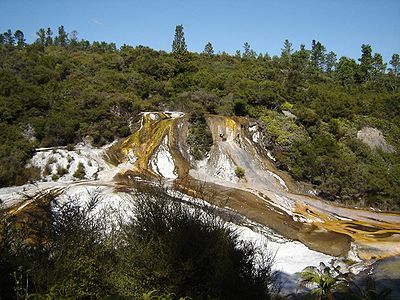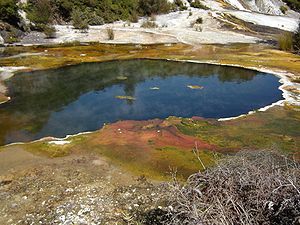
Orakei Korako
Encyclopedia

Taupo
Taupo is a town on the shore of Lake Taupo in the centre of the North Island of New Zealand. It is the seat of the Taupo District Council and lies in the southern Waikato Region....
on the banks of the Waikato River
Waikato River
The Waikato River is the longest river in New Zealand. In the North Island, it runs for 425 kilometres from the eastern slopes of Mount Ruapehu, joining the Tongariro River system and emptying into Lake Taupo, New Zealand's largest lake. It drains Taupo at the lake's northeastern edge, creates the...
in the Taupo Volcanic Zone
Taupo Volcanic Zone
The Taupo Volcanic Zone is a highly active volcanic V shaped area in the North Island of New Zealand that is spreading east -west at the rate of about 8mm per year...
, New Zealand
New Zealand
New Zealand is an island country in the south-western Pacific Ocean comprising two main landmasses and numerous smaller islands. The country is situated some east of Australia across the Tasman Sea, and roughly south of the Pacific island nations of New Caledonia, Fiji, and Tonga...
. It is also known as “The Hidden Valley”.
History of the region
From earliest times the Waikato Valley near Orakei Korako was occupied by Māori of the Ngāti Tahu sub-tribe of TuwharetoaNgati Tuwharetoa
Ngāti Tūwharetoa is an iwi descended from Ngātoro-i-rangi, the priest who navigated the Arawa canoe to New Zealand. The Tūwharetoa region extends from Te Awa o te Atua at Matata across the central plateau of the North Island to the lands around Mount Tongariro and Lake Taupo.The iwi is identified...
. By the early 19th century the Māori population had congregated at Orakei Korako, probably attracted by the hot springs, which were used for cooking and bathing. The date when the Ngāti Tahu vacated the valley to settle at other locations is not recorded, but it has been suggested that they left after the eruption of Mount Tarawera
Mount Tarawera
Mount Tarawera is the volcano responsible for New Zealand's largest historic eruption. Located 24 kilometres southeast of Rotorua in the North Island, it consists of a series of rhyolitic lava domes that were fissured down the middle by an explosive basaltic eruption in 1886, which killed over...
in 1886, when great changes are alleged to have occurred in the hot springs
Hot Springs
Hot Springs may refer to:* Hot Springs, Arkansas** Hot Springs National Park, Arkansas*Hot Springs, California**Hot Springs, Lassen County, California**Hot Springs, Modoc County, California**Hot Springs, Placer County, California...
. By the turn of the 20th century all but two families had moved from Orakei Korako.
The earliest known route from Rotorua
Rotorua
Rotorua is a city on the southern shores of the lake of the same name, in the Bay of Plenty region of the North Island of New Zealand. The city is the seat of the Rotorua District, a territorial authority encompassing the city and several other nearby towns...
to Taupo
Taupo
Taupo is a town on the shore of Lake Taupo in the centre of the North Island of New Zealand. It is the seat of the Taupo District Council and lies in the southern Waikato Region....
for early European travellers passed right through Orakei Korako, and it was the existing Māori who provided a dug out canoe for the river crossings. It was at this point in the early 20th century that the geothermal area was established as a visitor attraction. To transfer visitors across the then-swift Waikato River
Waikato River
The Waikato River is the longest river in New Zealand. In the North Island, it runs for 425 kilometres from the eastern slopes of Mount Ruapehu, joining the Tongariro River system and emptying into Lake Taupo, New Zealand's largest lake. It drains Taupo at the lake's northeastern edge, creates the...
they used the dug out canoe, until in the 1930s a wire-strop and pulley system was erected across the river, and a punt with a guiding rudder was used to catch the flow and propel the punt to the other side. The tourist resort was officially opened on 15 December 1937.
The first proposal for power development at Orakei Korako was made in 1904, but it wasn’t until 1955 that the scheme was finally approved. By May 1960 an earth-filled dam, rising 49 metres above the original river level, was placed and consolidated. The filling of Lake Ohakuri
Lake Ohakuri
Lake Ohakuri, at 12 km², is the largest artificial lake of the Waikato river system in New Zealand. It forms the reservoir for the Ohakuri hydroelectric power station. Construction of the dam, approved in 1955, began in 1956 and was completed in 1960. The lake was filled over 14 days in January and...
began on 19 January 1961 and was completed in 14 days.
Two of the world’s largest geysers were drowned by the lake: Minginui Geyser, which was once observed erupting up to 90 metres high (equal to the world's tallest currently active geyser, Steamboat Geyser
Steamboat Geyser
Steamboat Geyser, in Yellowstone National Park's Norris Geyser Basin, is the world's tallest currently-active geyser. During major eruptions, water may be thrown more than 300 feet into the air....
in Yellowstone National Park
Yellowstone National Park
Yellowstone National Park, established by the U.S. Congress and signed into law by President Ulysses S. Grant on March 1, 1872, is a national park located primarily in the U.S. state of Wyoming, although it also extends into Montana and Idaho...
), and the Orakeikorako Geyser, which on occasion could erupt up to 55 metres, and also gave the whole region its name.
Orakei Korako today

Pink and White Terraces
The Pink and White Terraces, also called Otukapuarangi or Te Tarata in Māori, were a natural wonder of New Zealand...
in the Mount Tarawera
Mount Tarawera
Mount Tarawera is the volcano responsible for New Zealand's largest historic eruption. Located 24 kilometres southeast of Rotorua in the North Island, it consists of a series of rhyolitic lava domes that were fissured down the middle by an explosive basaltic eruption in 1886, which killed over...
eruption of 1886. In peak wet conditions up to 20 million litres of silica-enriched water per day may flow over the terrace and into Lake Ohakuri.
The Emerald Terrace continues 35 metres under the lake, which was formed for hydropower
Hydropower
Hydropower, hydraulic power, hydrokinetic power or water power is power that is derived from the force or energy of falling water, which may be harnessed for useful purposes. Since ancient times, hydropower has been used for irrigation and the operation of various mechanical devices, such as...
generation in 1961. This raised the Waikato River
Waikato River
The Waikato River is the longest river in New Zealand. In the North Island, it runs for 425 kilometres from the eastern slopes of Mount Ruapehu, joining the Tongariro River system and emptying into Lake Taupo, New Zealand's largest lake. It drains Taupo at the lake's northeastern edge, creates the...
level by 18 metres at Orakei Korako, flooding approximately 200 alkaline hot springs
Hot Springs
Hot Springs may refer to:* Hot Springs, Arkansas** Hot Springs National Park, Arkansas*Hot Springs, California**Hot Springs, Lassen County, California**Hot Springs, Modoc County, California**Hot Springs, Placer County, California...
and 70 geysers (or two thirds of the active thermal area). Some of these thermal features still discharge, with their presence evident as gas bubbles rising from the vents in the lake bed.
Despite the loss of so many of its thermal features under the artificial lake, Orakei Korako remains the largest geyser field in New Zealand, with up to 35 active geysers. The most famous of these is the Diamond Geyser, whose unpredictable eruptions can last from a few minutes to many hours, ejecting boiling water as high as nine metres.
The three terraces above the lakeside Emerald Terrace are great fault scarp
Fault scarp
A fault scarp is the topographic expression of faulting attributed to the displacement of the land surface by movement along faults. They are exhibited either by differential movement and subsequent erosion along an old inactive geologic fault , or by a movement on a recent active fault...
s formed by a massive earthquake
Earthquake
An earthquake is the result of a sudden release of energy in the Earth's crust that creates seismic waves. The seismicity, seismism or seismic activity of an area refers to the frequency, type and size of earthquakes experienced over a period of time...
in 131 AD, around the time when Lake Taupo
Lake Taupo
Lake Taupo is a lake situated in the North Island of New Zealand. With a surface area of , it is the largest lake by surface area in New Zealand, and the second largest freshwater lake by surface area in geopolitical Oceania after Lake Murray ....
(a supervolcano
Supervolcano
A supervolcano is a volcano capable of producing a volcanic eruption with an ejecta volume greater than 1,000 cubic kilometers . This is thousands of times larger than most historic volcanic eruptions. Supervolcanoes can occur when magma in the Earth rises into the crust from a hotspot but is...
) was last erupting. They are mostly covered in hot water algae, or cyanobacteria, which grows in temperatures between 35-59 degrees Celsius, the colours dependent on the species, with green, yellow and black the most common.
At the base of the two lower terraces – named Rainbow and Cascade Terraces – are several small geysers, including the intermittently active Sapphire Geyser, and the Hochstetter Pool (named after Austrian pioneer geologist Ferdinand von Hochstetter
Ferdinand von Hochstetter
Christian Gottlieb Ferdinand Ritter von Hochstetter was a German geologist.He was born at Esslingen, Württemberg, the son of Christian Ferdinand Friedrich Hochstetter , a clergyman and professor at Bonn, who was also a botanist and mineralogist...
, who visited the area in 1859), which erupted in November 1954 and played as a geyser until mid-1955, ceasing suddenly after swarms of subterranean earthquakes.
The third and largest great fault scarp in the valley is called the Golden Fleece Terrace (named Te Kapua by the Māori people, meaning “The Cloud”), which is five metres high and 40 metres long, with a beautiful white crystal-like sinter coating. At the base are numerous vents where geysers have come and gone over the years, with the most recent, Wairiri Geyser.
Atop this terrace is the Artist’s Palette, a 10,000 m² silica sinter terrace covered with clear blue alkali chloride pools and irregularly erupting geysers. To one side of this topmost terrace a new geyser began to erupt in 2001, possibly the beginnings of a further terrace.
Also at Orakei Korako is the Ruatapu Cave, one of only two caves in the world known to exist in a geothermal field. The cave extends 45 metres, with a vertical drop of 23 metres, to a shallow pool of clear, sulfate-rich, warm acid water. (The pool’s chemical composition gives it the unique ability to clean jewellery.)
Another notable feature at Orakei Korako is the Soda Fountain, which burst into life in 1984 after a 17 year dormancy.
To the south of this feature, high atop a cliff above Lake Ohakuri, are three further geysers, Kurapai, Ellan Vannin and Benedix Washer Geysers, in an area not accessible to the public because it is too dangerous. Temperatures of 100 degrees Celsius have been recorded here just 100 to 150 mm below the ground. Of these geysers, Kurapai Geyser is the most significant, and can sometimes be seen erupting from across the lake in the visitor's centre.
The Orakei Korako geothermal system now has some protection from further development, although the nearby Ngatamariki Geothermal Development at Tahorakuri gained resource consent in 2010 despite its possible effects on Orakei Korako.

